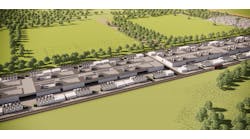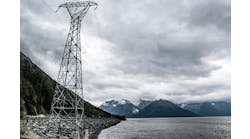It may get much hotter in Los Angeles County in coming decades, exposing grid vulnerabilities and challenging electric reliability, according to university researchers.
LA County’s electricity infrastructure may suffer capacity losses as high as 240 MW, as population grows and temperatures rise from 2021-2060, according to “Climate Change in Los Angeles County: Grid Vulnerability to Extreme Heat,” a study by the University of California, Los Angeles and Arizona State University.
Investing in energy efficiency measures — related to air conditioning in particular — non-wires alternatives and clean distributed energy, such as solar plus storage microgrids, can serve as alternatives to conventional solutions. Climate-smart land use planning also needs to figure prominently in the county’s electric resource planning, according to the study.
“We need to move to a decarbonized economy, and that will require significant changes in land use, among other factors,” said Stephanie Pincetl, project principal investigator, professor in residence and director of the California Center for Sustainable Communities Institute of the Environment.
Heat waves jeopardize electric reliability
The UCLA-ASU research team used two pathway scenarios based on UN Intergovernmental Panel on Climate Change models to project daily maximum temperatures within two square kilometers throughout Los Angeles County.
The researchers modeled the effects of population growth, building ‘densification,’ AC penetration, AC efficiency, and rising air temperatures from 2020-2060.
The county experienced average annual maximum temperatures of 95-110°F from 1981-2000. The study’s business-as-usual forecast sees a 4.3°F rise by mid-century. But a high case scenario finds future temperature reaching 112-114°F.
In contrast, average temperatures would level off and wind up about 3°F warmer by mid-century if the report’s recommendations are implemented.
Warming will be greater in low-lying valleys and inland areas as opposed to coastal areas. Furthermore, the number of days hotter than 95°F in any given year will increase region-wide.
Effect of energy efficiency on Los Angeles
Higher peak-hour demand for the study’s high-population growth projections inside the LA Basin grid service territory can be offset by aggressively implementing energy efficiency measures, the research team concluded.
That’s not the case in LA County outside of the city of LA, where the study finds peak-hour demand increasing by 1.5 GWh even with aggressive energy efficiency measures.
Similarly, researchers see peak-hour demand in northern areas of LA County, including Lancaster, Palmdale and Santa Clarita, increasing 300-900 GWh. The grid will need an additional 0.9-1.1 GW by 2060 to maintain electric reliability.
Investing in distributed energy resources as opposed to new substations or transmission lines (the traditional options) may prove more cost-effective, according to the report authors.
Wildfires up the stakes
The historic forest fires raging in California, among other extreme heat-related events, highlight what’s at stake. “They [the forest fires] are very serious and we worry that further ex-urban development will increase vulnerability,” Pincetl said.
The findings and recommendations “point toward the need for greater in-fill development, and the need to develop much more efficient land use patterns. Common-wall development is much less energy intensive than single-family dwellings, and it makes little sense to build in areas that are going to be even hotter than they are now.”
Associated with this are initiatives to reduce the urban heat island effect by addressing urban albedo — reflective pavements, building surfaces and roofs, Pincetl added. Vehicular traffic is also a significant to the urban heat island effect, she noted.
The researchers’ findings also come as California embarks on a new goal to increase use of emissions-free energy.
Among other key takeaways from the report:
- Santa Clarita is the community at the greatest risk of service interruptions due to substation overloading (load factor ≥2) by 2060.
- Depending upon population growth, Los Angeles County could need an 8 to 11 percent increase (0.9–1.1 GW) in substation capacity, distributed energy resources, or peak load shifting by 2060 to keep substation load factors at or below one during the worst-case heat waves.
- Building Climate Zone 9, spanning from West Valley to Pomona, would require 700 MW additional capacity, distributed energy resources, or load shifting to avoid overloading local substation capacities.
- Multi-family (shared wall) housing units could reduce peak demand by up to 50 percent per capita relative to single-family detached housing.
- The in-basin area of the county may be able to meet increasing peak demand if it develops high-efficiency, high density housing. However, the portion of SCE (Southern California Edison) service territory in California Building Climate Zone 9, spanning from West Valley to Pomona, would require 700 MW additional capacity, distributed energy resources, or load shifting to avoid overloading local substation capacities.
- While further improvements in air conditioner ratings beyond SEER 16 can be effective in reducing total energy consumption, a new peak performance rating at or above 45°C would be useful to adapt air conditioners’ performance for extreme heat.
Funded by the California Energy Commission for California’s Fourth Climate Change Assessment, the study is available here.
Track news about electric reliability and microgrids. Subscribe to the free Microgrid Knowledge newsletter.







